Related Research Articles
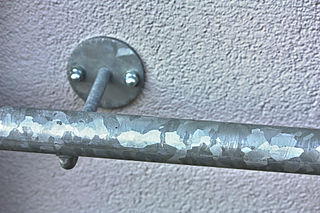
Galvanization or galvanizing is the process of applying a protective zinc coating to steel or iron, to prevent rusting. The most common method is hot-dip galvanizing, in which the parts are submerged in a bath of hot, molten zinc.

Stainless steel is an alloy of iron that is resistant to rusting and corrosion. It contains at least 11% chromium and may contain elements such as carbon, other nonmetals and metals to obtain other desired properties. Stainless steel's resistance to corrosion results from the chromium, which forms a passive film that can protect the material and self-heal in the presence of oxygen.

Corrosion is a natural process that converts a refined metal into a more chemically stable oxide. It is the gradual deterioration of materials by chemical or electrochemical reaction with their environment. Corrosion engineering is the field dedicated to controlling and preventing corrosion.
Passivation, in physical chemistry and engineering, refers to coating a material so it becomes "passive", that is, less readily affected or corroded by the environment. Passivation involves creation of an outer layer of shield material that is applied as a microcoating, created by chemical reaction with the base material, or allowed to build by spontaneous oxidation in the air. As a technique, passivation is the use of a light coat of a protective material, such as metal oxide, to create a shield against corrosion. Passivation of silicon is used during fabrication of microelectronic devices. In electrochemical treatment of water, passivation reduces the effectiveness of the treatment by increasing the circuit resistance, and active measures are typically used to overcome this effect, the most common being polarity reversal, which results in limited rejection of the fouling layer.
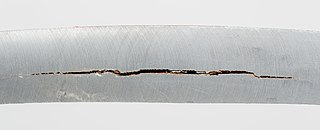
Hydrogen embrittlement (HE), also known as hydrogen-assisted cracking or hydrogen-induced cracking (HIC), is a reduction in the ductility of a metal due to absorbed hydrogen. Hydrogen atoms are small and can permeate solid metals. Once absorbed, hydrogen lowers the stress required for cracks in the metal to initiate and propagate, resulting in embrittlement. Hydrogen embrittlement occurs most notably in steels, as well as in iron, nickel, titanium, cobalt, and their alloys. Copper, aluminium, and stainless steels are less susceptible to hydrogen embrittlement.

Pitting corrosion, or pitting, is a form of extremely localized corrosion that leads to the random creation of small holes in metal. The driving power for pitting corrosion is the depassivation of a small area, which becomes anodic while an unknown but potentially vast area becomes cathodic, leading to very localized galvanic corrosion. The corrosion penetrates the mass of the metal, with a limited diffusion of ions.

The Institute of Materials, Minerals and Mining (IOM3) is a UK engineering institution whose activities encompass the whole materials cycle, from exploration and extraction, through characterisation, processing, forming, finishing and application, to product recycling and land reuse. It exists to promote and develop all aspects of materials science and engineering, geology, mining and associated technologies, mineral and petroleum engineering and extraction metallurgy, as a leading authority in the worldwide materials and mining community.
Michael A. Streicher was an American metallurgist and engineer who became internationally recognized for his work on the testing and development of corrosion-resistant stainless steel alloys. He published widely in technical journals and textbooks and received numerous patents for his inventions.
Corrosion engineering is an engineering specialty that applies scientific, technical, engineering skills, and knowledge of natural laws and physical resources to design and implement materials, structures, devices, systems, and procedures to manage corrosion. From a holistic perspective, corrosion is the phenomenon of metals returning to the state they are found in nature. The driving force that causes metals to corrode is a consequence of their temporary existence in metallic form. To produce metals starting from naturally occurring minerals and ores, it is necessary to provide a certain amount of energy, e.g. Iron ore in a blast furnace. It is therefore thermodynamically inevitable that these metals when exposed to various environments would revert to their state found in nature. Corrosion and corrosion engineering thus involves a study of chemical kinetics, thermodynamics, electrochemistry and materials science.

Martin Stratmann is a German electrochemist and materials scientist. He is one of the directors at the Max-Planck-Institut für Eisenforschung in Düsseldorf since 2000, and heads its department of Interface Chemistry and Surface Engineering.

Mary Patricia Ryan is a Professor of Materials Science at Imperial College London and a Fellow of the Royal Academy of Engineering.
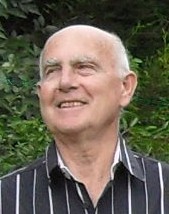
Kenneth Claughan Mills, was head of the Slags group at the National Physical Laboratory and a visiting professor in the Department of Materials at Imperial College London.
Ruth Cameron FInstP FIOM3 is a British materials scientist and professor at the University of Cambridge. She is co-director of the Cambridge Centre for Medical Materials. She studies materials that interact therapeutically with the body.
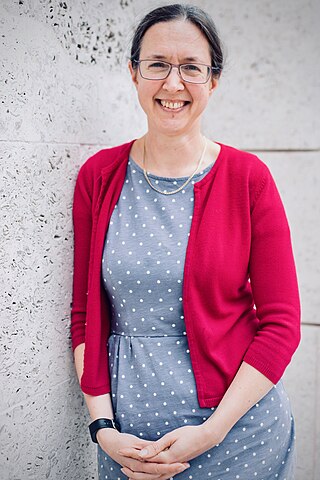
Rachel Angharad Oliver is a Professor of Materials Science at the University of Cambridge and a fellow of Robinson College, Cambridge. She works on characterisation techniques for gallium nitride materials for light-emitting diodes and laser diodes.
Rachel Clare Thomson is a professor of Materials Science and Engineering, and Pro Vice Chancellor of Teaching at Loughborough University. She is known for her expertise in measuring and predicting the behaviour of materials for high temperature power generation, as well as the development of higher education and research programmes.
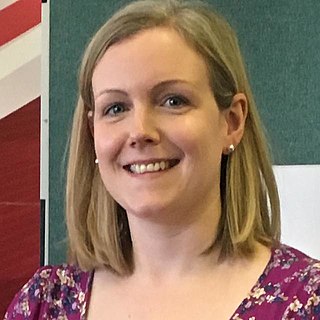
Eleanor Josephine Schofield is the Head of Conservation & Collections Care at the Mary Rose Trust. She is an honorary Professor at the University of Kent. In 2015 she was selected as one of the Royal Society of Chemistry 175 Faces of Chemistry.
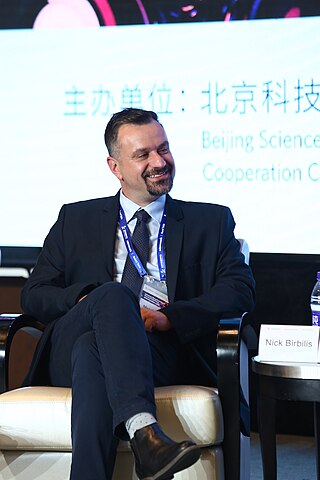
Nick Birbilis is an Australian engineer and academic. He is presently the Executive Dean of the Faculty of Science, Engineering, and Built Environment, at Deakin University. Birbilis was previously the Dean, and Deputy Dean of the College of Engineering and Computer Science at the Australian National University. He is of Greek-Australian background. Birbilis works in the field of materials science and engineering, having made contributions in the area of materials design, materials durability and materials characterisation. He is a Fellow of the Electrochemical Society (US), a Fellow of NACE (US), a fellow of Engineers Australia, a Fellow of the International Society of Electrochemistry (ISE)., and a Fellow of ASM International.
Thomas James Marrow is a British scientist who is a professor of nuclear materials science at the University of Oxford and holds the James Martin Chair in Energy Materials. He specialises in physical metallurgy, micromechanics, and X-ray crystallography of engineering materials, mainly ceramic matrix composite and nuclear graphite.
Mary Grace Burke is an American materials scientist who is an emeritus professor at the University of Manchester. She was awarded the 2020 International Metallographic Society Henry Clifton Sorby Award and is the President of the Royal Microscopical Society.
David Dye is a Professor of Metallurgy at Imperial College London. Professor Dye specialises in fatigue and micromechanics of aerospace and nuclear materials, mainly Ni/Co superalloys, Titanium, TWIP steel, and Zirconium alloys.
References
- 1 2 3 4 "Professor Alison Davenport, Metallurgy and Materials - University of Birmingham". www.birmingham.ac.uk. Retrieved 2018-10-26.
- ↑ "Queen's Birthday Honours for King's Graduates". www.kings.cam.ac.uk. 2018-06-11. Retrieved 2018-10-26.
- 1 2 Davenport, Alison Jean (1987). Passivation of amorphous and polycrystalline metals. jisc.ac.uk (PhD thesis). University of Cambridge. OCLC 53516295. EThOS uk.bl.ethos.328717.
- 1 2 3 4 "Shedding Light on Corrosion". www.birmingham.ac.uk. Retrieved 2018-10-26.
- ↑ Division, Electrochemical Society Corrosion (2001). State-of-the-art Application of Surface and Interface Analysis Methods to Environmental Material Interactions: In Honor of James E. Castle's 65th Year, Proceedings of the International Symposium. The Electrochemical Society. ISBN 9781566773119.
- ↑ "rae 2008 : submissions : ra5a". www.rae.ac.uk. Retrieved 2018-10-26.
- 1 2 "Technical Report 09-02" (PDF). NAGRA. 2009. Retrieved 2018-10-26.
- 1 2 "Cambridge Materialeyes" (PDF). MSM. 2013. Retrieved 2018-10-26.
- ↑ "Prof. Alison Davenport (School of Metallurgy and Materials, University of Birmingham, UK) — Solid Mechanics and Materials Engineering". www.eng.ox.ac.uk. Retrieved 2018-10-26.
- 1 2 "Professor Alison Davenport - Science and Technology Facilities Council". stfc.ukri.org. Archived from the original on 2018-10-27. Retrieved 2018-10-26.
- ↑ Yu, Fei; Addison, Owen; Baker, Stephen J; Davenport, Alison J (2015). "Lipopolysaccharide inhibits or accelerates biomedical titanium corrosion depending on environmental acidity". International Journal of Oral Science. 7 (3): 179–186. doi:10.1038/ijos.2014.76. ISSN 2049-3169. PMC 4582556 . PMID 25634122.
- ↑ Street, Steven R.; Cook, Angus J.M.C.; Mohammed-Ali, Haval B.; Rayment, Trevor; Davenport, Alison J. (2017). "The Effect of Deposition Conditions on Atmospheric Pitting Corrosion Location Under Evans Droplets on Type 304L Stainless Steel" (PDF). Corrosion. 74 (5): 520–529. doi:10.5006/2614. ISSN 0010-9312.
- ↑ Cook, Angus J. M. C.; Padovani, Cristiano; Davenport, Alison J. (2017). "Effect of Nitrate and Sulfate on Atmospheric Corrosion of 304L and 316L Stainless Steels" (PDF). Journal of the Electrochemical Society. 164 (4): C148–C163. doi:10.1149/2.0921704jes. ISSN 0013-4651. S2CID 99388012.
- ↑ Davenport, A. J.; Guo, L.; Mi, N.; Mohammed-Ali, H.; Ghahari, M.; Street, S. R.; Laycock, N. J.; Rayment, T.; Reinhard, C. (2014). "Mechanistic studies of atmospheric pitting corrosion of stainless steel for ILW containers". Corrosion Engineering, Science and Technology. 49 (6): 514–520. doi:10.1179/1743278214y.0000000183. ISSN 1478-422X. S2CID 136023665.
- ↑ "Final Report Summary - STAMPEM (STAble and low cost Manufactured bipolar plates for PEM Fuel Cells) | Report Summary | STAMPEM | FP7 | CORDIS | European Commission". CORDIS | European Commission. Retrieved 2018-10-26.
- ↑ "H.H. Uhlig Award". www.nace.org. Archived from the original on 2018-10-27. Retrieved 2018-10-26.
- ↑ "2008 Aqueous Corrosion Conference GRC". www.grc.org. Retrieved 2018-10-26.
- ↑ KTN. "KTN | A vision of the opportunities for advanced materials: Short 'vision papers' from the Advanced Materials Leadership Council". KTN. Retrieved 2018-10-26.
- ↑ "IOM3 | The Institute of Materials, Minerals and Mining". www.iom3.org. Retrieved 2018-10-26.
- ↑ "About Us | CCPi Tomographic Imaging". www.ccpi.ac.uk. Retrieved 2018-10-26.
- ↑ "WIM seminar success in Birmingham | IOM3". www.iom3.org. Retrieved 2018-10-26.
- ↑ "Alison DAVENPORT". www.thegazette.co.uk. Retrieved 2018-10-26.
- ↑ "University of Birmingham academics' success in Queen's Birthday Honours List". www.birmingham.ac.uk. Retrieved 2018-10-26.
- ↑ "Birthday Honours 2018: the Prime Minister's list (CSV) - GOV.UK". www.gov.uk. Retrieved 2018-10-26.